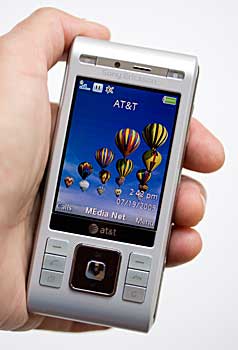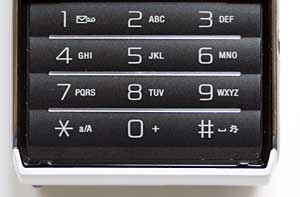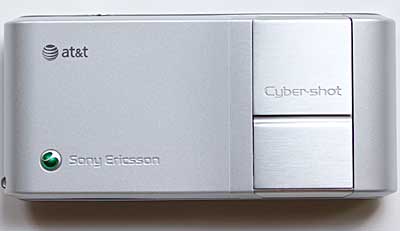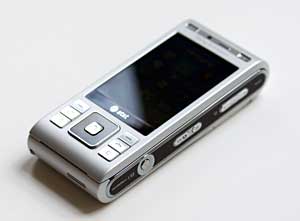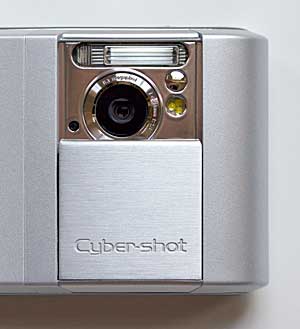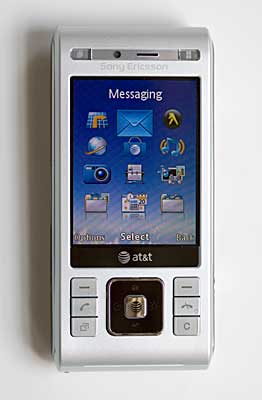
|
||||||||||||||||||
You can set the phone to automatically answer a call when the slider is opened (on by default), and you can set it to end a call when the slider is closed (this is turned off by default). The phone automatically goes into keyguard mode when you close the slider and unlocks when you open it. You can also turn on automatic key locking. The 2.4" QVGA 240 x 320 display is sharp and colorful. It may be small but it's wonderful looking and remains visible outdoors, unlike the OLED display on the Nokia N85 and N86. Outdoor visibility is always important, and it's crucial with a high end camera phone-- who wants to guess at what they're shooting? Sony Ericsson states that the display is made of hardened mineral glass that's scratch resistant. There's an accelerometer that handles screen orientation when in multimedia applications and the web browser. Phone and Reception AT&T's version of the Sony Ericsson C905a is a quad band GSM world phone that works anywhere in the world GSM service is available. It has EDGE on the GSM bands and 3G HSDPA on AT&T's 3G bands and on the European 2100MHz band. The C905a supports smart-dialing, speed dial and voice dialing via recorded voice tags. Voice dialing with recorded tags is very reliable, though inconvenient since you must first record the tags. Voice dialing works well with the phone and via Bluetooth headsets. Start voice command by pressing and holding the volume up or down button (both work) until the on-screen prompt appears. That prompt tells you to wait for the beep before speaking, but as with the Sony Ericsson W518a, we noted that the beep is so soft that you can barely hear it even if the phone is against your ear.
Voice quality on AT&T's 3G network in the Dallas area is excellent. It's on par with Nokia N and E series smartphones and the BlackBerry Bold. Reception is middle of the road: a bit stronger than the Samsung Eternity but weaker than the Bold and several Nokia phones (to be fair, high end Nokia phones have excellent reception). We have no qualms recommending the C905a as an excellent voice phone, but if you live in a marginal 3G coverage area, be warned that the phone will lose 3G and switch to EDGE. The phone's address book can hold up to 1,000 records with a large selection of fields including email addresses, website, physical address, a variety of phone numbers, birthday, photo caller ID, ringtone, message tone, voice tag and notes. The C905a comes with a variety of ringtones and you can use your own MP3 and AAC files as ringtones. It has profiles and vibrate for calls/alarms/messages. The Sony Ericsson works well with Bluetooth headsets. We tested a variety of Bluetooth headsets including the Plantronics Discovery 925 and Jawbone 2 and they had good range and excellent voice quality. The phone also works with A2DP Bluetooth stereo headsets for music playback and voice. NetFront is on board for full HTML web browsing and it does an excellent job with WAP and full HTML sites. It supports Javascript including dHTML, frames, SSL, cache control, cookies and in general does a very good job of desktop style rendering. It even has a pointer mode like Nokia's S60 webkit based browsers, so you can move around the page with the pointer rather than moving from link to link. If you hate scrolling, there's a smart fit mode that reflows web pages to avoid side-to-side scrolling.
Camera The centerpiece of the Cyber-shot C905a is clearly its camera. At 8.1 megapixels resolution with a good autofocus f2.8 lens and a Xenon flash plus a low light LED focusing light, the camera looks yummy on paper. The 5.9mm focal length is roughly equivalent to a 38mm modest wide angle in 35mm (or full frame digital SLR) terms-- close to the super-shooter Nokia N82 of old with its 5.6mm focal length. How is it in reality? Excellent! In terms of resolution there's little to directly compare the C905 to in the US other than the Samsung Memoir. We will compare it to the 5 megapixel Carl Zeiss autofocus Nokia N series phones since they too live in the realm of high end imaging and are available in the US (though not through a carrier). The Nokia N86 NAM (US) version isn't available as of this writing, so we can't compare that 8 megapixel shooter, but clearly the C905a wins in the low light arena since it has a Xenon flash while Nokia sadly went with their usual dual LED flash (why Nokia has abandoned the much superior Xenon flash, we don't know).
We assume you're interested in photography and intend to use your images for a digital album, print or on a website in larger sizes (why buy this phone otherwise?). The Sony Ericsson C905a is up to these tasks and takes photos that are suitable for very good 5 x 7 to 8 x 10 prints. With a maximum 3264 x 2448 resolution, there's plenty of image data to work with, and when resized down just a bit to 2500 x 1875 pixels, the images look very sharp and natural. At 100%, digital processing artifacts are visible but are within the range of what you'd see with a mid-priced 8 MP point and shoot camera. Were it not for the lack of optical zoom, a feature generally not found on camera phones, the C905a could replace your point and shoot. The camera does have 16x digital zoom, but digital zoom degrades image quality. The Xenon flash, while not as powerful as that on a dedicated camera, is much more powerful than an LED flash and works well with subjects up to 6 feet away. It's bright enough that if you shoot a light colored or reflective subject 1 or 2 feet away, you'll see some overexposure of highlights in an otherwise very well illuminated picture. The Xenon flash makes indoor, low light photography possible, and we got remarkably good shots even in very dimly lit rooms. In this respect, it blows away Nokia's LED-flash equipped N series phones which take poor low light photos. We found it edged out the Samsung Memoir for indoor shots as well, even though the Memoir also sports a Xenon flash. The Cyber-shot's flash images had less noise and better exposure than the Memoir's. Outdoors in mid-level natural lighting, from cloudy to early evening shots, the camera also did very well with proper exposure, pleasing color saturation and natural colors. The only thing that baffles the camera's metering are extremely bright, contrasty shots. This might not be a problem in rainy Seattle or in the north east, but here in Texas where the sun is brutally strong and the skies clear, the camera over-exposed highlights. Changing scene settings didn't do much nor did using the smart contrast setting which just seems to apply some post-processing just after the shot is taken. Adjusting the exposure (a quick setting available on the d-pad) to drop down up to -1EV helped. There' s no manual ISO setting, but the camera does select good values: bright outdoor shots are taken at ISO 64, indoor shots with flash are taken at ISO 200 and indoor shots with the flash turned off are taken at ISO 400. We'd like to see a firmware update to improve bright outdoor scenes, but AT&T doesn't have a strong record for releasing Sony Ericsson firmware updates.
The d-pad's embedded camera controls. The camera has a variety of scene modes: auto, twilight landscape, twilight portrait, landscape, portrait, snow/beach, document and sports. We found auto did the trick in most cases. Focusing modes are auto, macro, infinity (for landscapes) and face detection (the camera detects up to 3 faces and focuses on them). It did a good job of focusing macro shots even when set to auto and portraits were sharp even without face detection (busy backgrounds and multiple faces do better with face detection). True landscape nature shots of wide open spaces, be it a large backyard or golf course with no mid-points of focus, could sometimes be sharper. It seems that the camera sets itself to infinity focus and that can reduce detail sharpness as viewed at 100%. We found that the Samsung Memoir did a better job of taking sharp nature landscape shots. This wasn't a problem in urban locations, city streets and outdoor shopping areas because there are many points of focus. We're being very picky since the Cyber-shot C905 is at the top echelon of camera phones-- landscapes are by no means horrid: see the golf course shot below and the 100% crop where a house's balcony in the distance has good detail. Images at max resolution average 1.4 to 1.9 megs. Get a large Memory Stick Micro M2 card if you plan to takes lots of snaps. Videos don't take up much space since they're QVGA resolution (VGA Nokias can use up to a meg a second!). Just as we moan about Nokia and their fear of Xenon flashes, we wonder why Sony Ericsson just can't cough up a Cyber-shot that takes VGA resolution video at 30fps. The C905a is capped at 320 x 240 QVGA @ 30fps, and video quality is better than most camera phones on the US market but can't compete with recent Nokia 5 MP camera phones like the N85, N96 and N97. The camera has settings for image stabilization (which doesn't seem to degrade image quality), shutter sounds, save location, metering (spot and average center weighted), white balance, night mode, resolution, geotagging, flash (auto, off and red eye reduction) and BestPic (it takes a series of shots instead of one and you can save the best or all of the shots). It takes about 2 seconds to launch the camera application from standby and about 1 second to focus and shoot a photo. If you've got a Sony Ericsson K850i and are thinking of upgrading: yes the Cyber-shot C905a takes noticeably better shots and better video (though video clearly isn't a strong point for either camera phone). Images are sharper with more detail and there's less noise indoors. Likewise, the C905a beats the venerable Nokia N95 in terms of sharpness and noise, especially for low light shots. For outdoor well lit photos, it's a closer call with the Nokia N97. That phone takes excellent shots, albeit with few pixels for large prints, but the N97 can't come close for low light shots. As with the Memoir, the N97's large touch screen fades in sun, making it hard to see your shot. Below: sample photos taken at 8MP resolution with auto settings and resized to fit this page. Click on an image to see a larger version in a new window. The link below each image will show a 100% crop taken from that image. Software and Syncing Desktop syncing, once the purview of smartphones , is now available on a variety of feature phones. Sony Ericsson jumped on the syncing bandwagon early on with their version of PC Suite and they also produce iSync plugins for several of their phones. You can sync PIM data via PC Suite to Windows machines and Mac OS X via iSync and Sony Ericsson's plugins. Both PC Suite and the iSync plugin are available for free from Sony Ericsson's web site but are not included on the companion CD that has only the PDF manual and an interactive, multimedia-based tutorial. The phone comes with the usual Sony XMB media player (more about that under Multimedia), a file manager (My Stuff), the address book, calendar, notes, tasks, NetFront web browser (titled Media Net in AT&T fashion), email, IM, FM radio, AT&T Navigator, a voice recorder, call history, alarms, a password keeper, stopwatch and more. Sony Ericsson's PhotoDJ and VideoDJ are here for editing photos and video directly on the camera. You can also print directly from the phone via USB and Bluetooth. There's a large helping of AT&T's usual subscription applications including 6 demo games, MusicID, My-Cast Weather, Wiki Mobile, Mobile Banking, XM Radio and AT&T's Mall for application/ringtones/music shopping. Most of these apps are tucked away under the applications listing in Tools and Apps, so they don't clutter up the user interface.
Multimedia We like Sony's XrossMediaBar (XMB) user interface for multimedia (the icon labeled "Entertainment"). It's the same as that used on the PSP and PSP3, and it's an easy and attractive way to navigate through and view/play photos, video, music and games. The music player is full featured and it automatically updates your library when you add tunes to an M2 card or internal memory. The video player can play in full screen, landscape mode and we threw a variety of MPEG4 videos in iPhone-friendly format at the player and it did an excellent job with good sound and no apparent frame drops. The bottom firing speaker sounds surprisingly good and it's loud (just don't cover the speaker with your hand). Sound via A2DP Bluetooth headset was excellent as was wired stereo via a Sony Ericsson Fast port headset (not included). There's an FM radio with RDS. This requires a wired headset to act as the antenna, and AT&T does not include one, nor are they easy to find. Thanks, AT&T. The phone plays CV, AT&T's streaming video service, and it can do so in full screen, landscape mode. CV looks great on the C905a thanks to good data speeds and that crystal-sharp display. GPS The C905a has an integrated GPS that works with AT&T Navigator (aka TeleNav). The GPS gets a fix quickly outdoors, but couldn't manage a fix indoors. It takes about 5 minutes for the GPS to settle down-- we noticed that it would lose the fix for just a second, resulting in the dreaded TeleNav "make a legal U-turn" command which it reneged on as soon as it had uttered the command. When Navigator does this, we know that it's momentarily lost its fix. There's some lag on the highway when driving at 60mph or faster, but the GPS is spot-on up to 50mph. Spoken directions are loud and clear via the phone's speaker but the screen is a tad small at 2.4" for visual aid while driving (but you should be looking at the road, right?). Navigator gives excellent spoken turn-by-turn directions along with current POIs and maps. We recommend it if you often need help finding your way around. AT&T discounts the monthly charge from $10 to $5 with their unlimited data plan (unlimited data + Navigator cost $20/month, unlimited data alone is $15). The C905 also worked fine with the signed version of Google Maps as well. Battery The Sony Ericsson ships with a 930mAh Lithium Ion battery that's replaceable. It lives under the back cover panel below the camera lens and the cover wraps around the bottom of the phone. Battery life varies greatly depending on what you do with the phone. Taking photos, especially with the Xenon flash on, consumes power fairly quickly-- after 100 shots, we had 25% charge remaining. The GPS also consumes quite a bit of power and the phone used 33% of its charge in a 45 minute navigation session. Using the phone for conversations and web browser over 3G had a relatively low impact on battery life and music playback with the screen off used extremely little power. In a day where we talked for 30 minutes over a Bluetooth headset, took 30 photos, surfed the web for 30 minutes and used the GPS for a 30 minute trip, we had 30% charge left. If you take lots of photos and/or use the GPS frequently, charge the C905a every 1 to 1.5 days. If you talk 30 minutes/day and take just a few photos and don't use the GPS, the phone should last 2 to 3 days on a charge. Conclusion If you're into photography and prefer traditionally designed phones, the Sony Ericsson Cyber-shot C905a should be on your short (very short) list of high megapixel camera phones available in the US. It takes superb shots and the Xenon flash shows up Nokia and allows for good indoor images. We'd like to see higher video resolution-- QVGA is absurdly low for an 8.1 megapixel camera phone and Nokia puts it to shame with their recent N series models. the C905's super-sharp and bright display makes an excellent viewfinder that doesn't wash out in sunlight as do most touch screen phones. It also looks great when viewing photos and video, though at 2.4", you won't want to spend hours doing this. The phone has strong multimedia and did a surprisingly good job of playing fairly high bitrate videos. The speaker sounds very good and the music player software is some of the best on a phone (excluding the iPhone). As a phone, the Sony Ericsson offers excellent voice quality but just average reception. It has all the creature comforts you'd expect including voice dialing, smart dial, a 1,000 record address book with a wealth of fields, custom ringtones, photo caller ID and speakerphone. The phone's many buttons are all about photography, but the key pad is large and easy to use for dialing and texting. The GPS works decently and NetFront is an excellent mobile browser that's as good as some smartphone web browsers. For the price, both retail and with contract, the Sony Ericsson C905a is well worth it. Though we do wish AT&T had included a wired headset since they're not easy to find and a starter M2 card.
Websites: wireless.att.com, www.sonyericsson.com Price: $179 with a 2 year contract after $50 rebate. $329 retail without contract after rebate.
| ||||||||||||||||||
